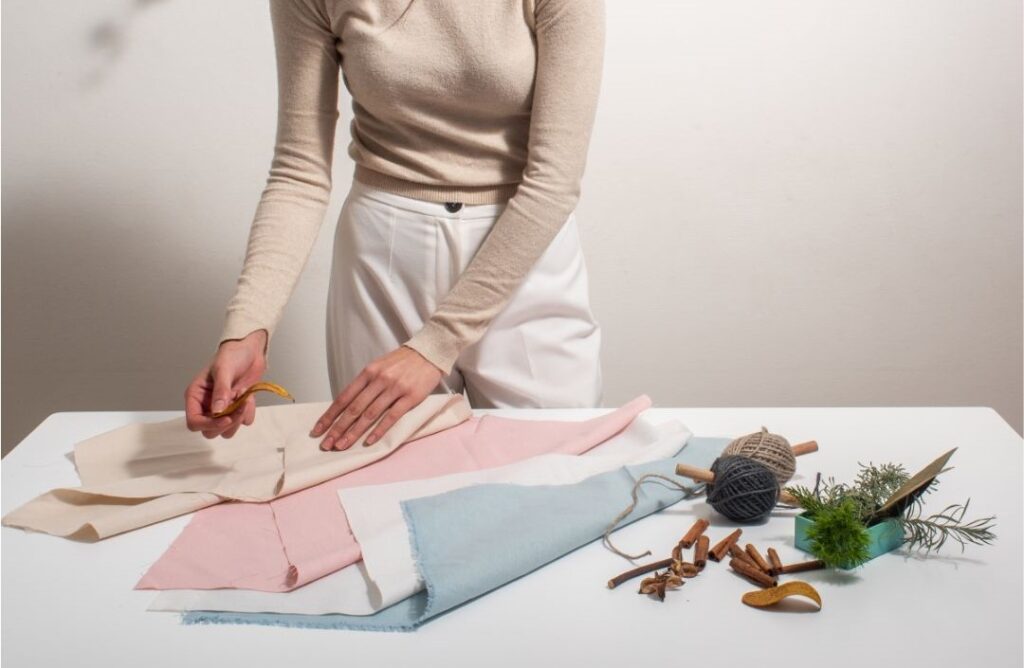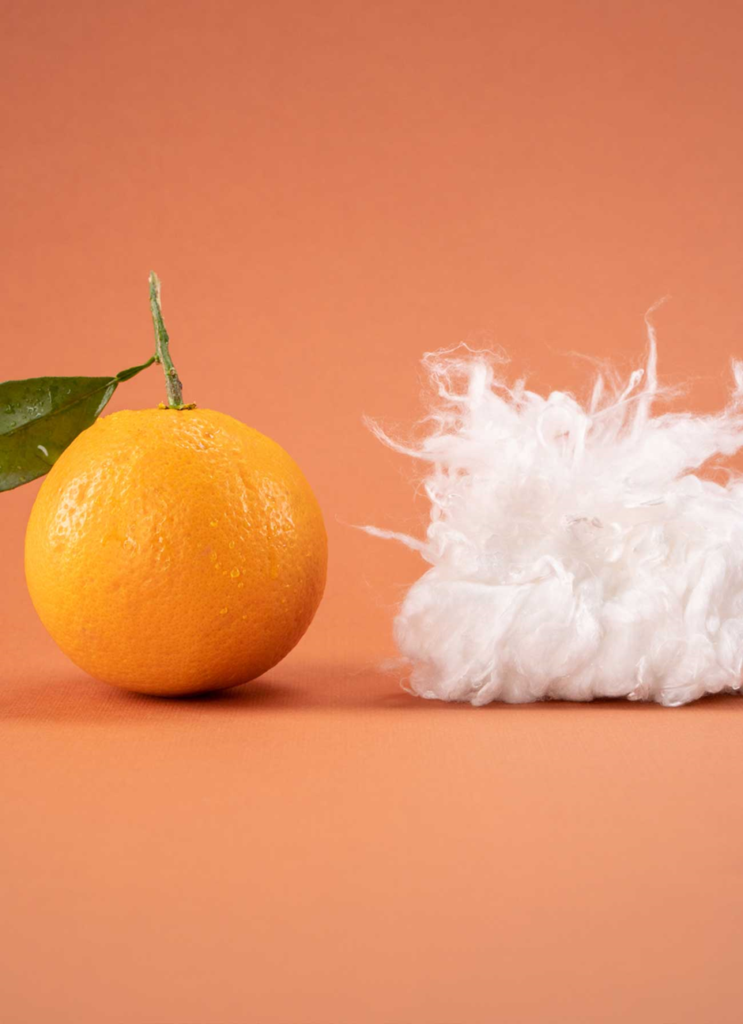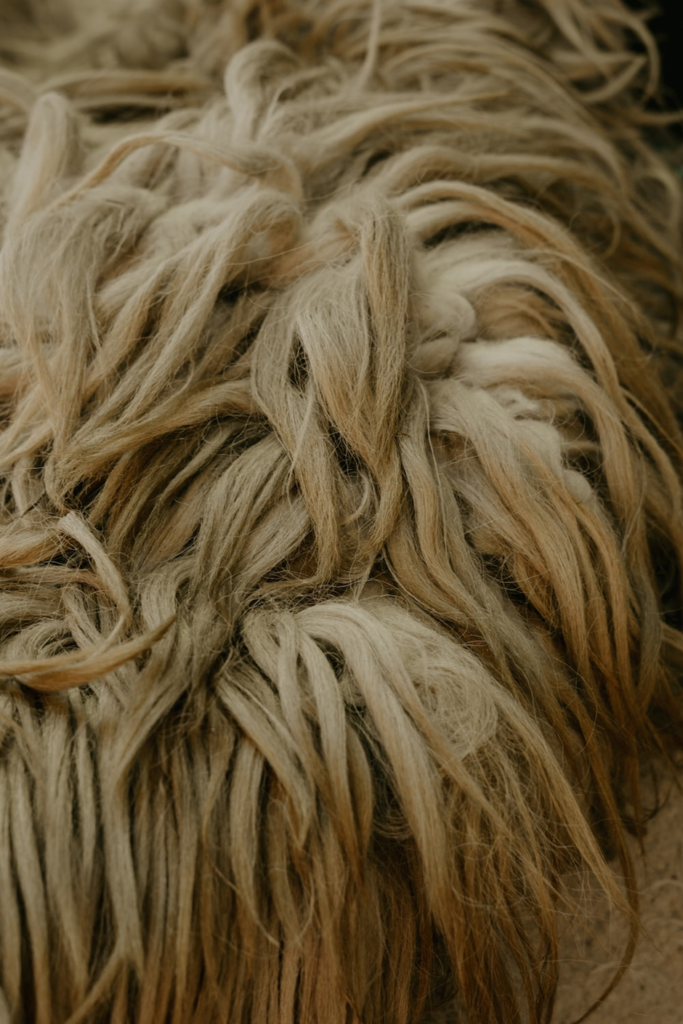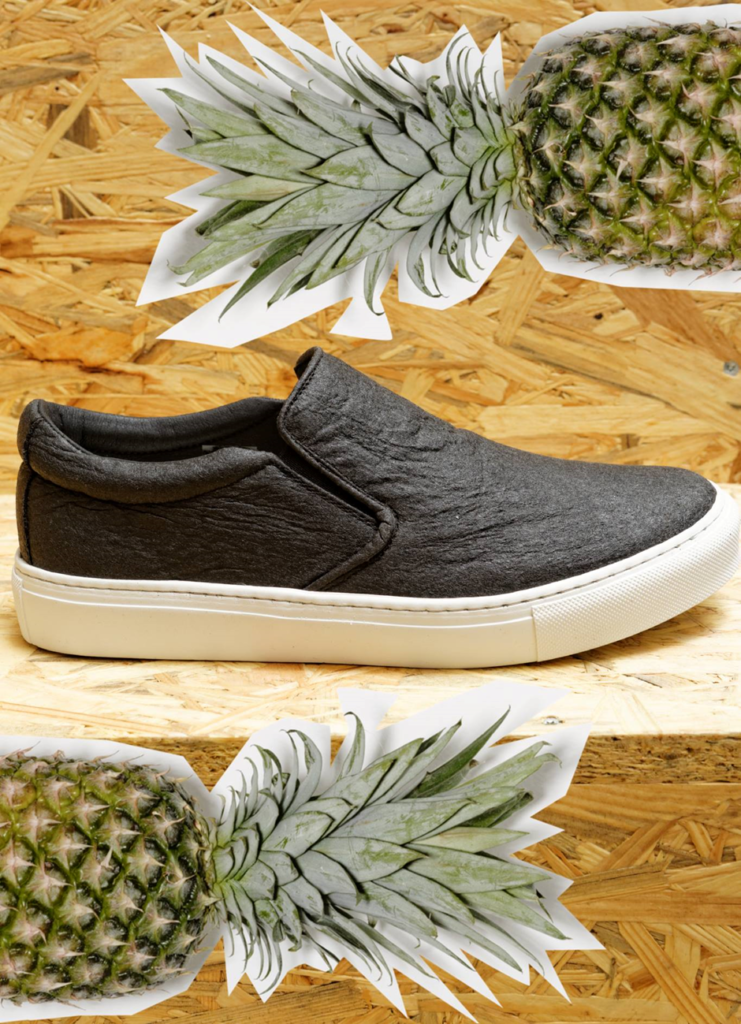Blog
THE MOST INFORMATIVE GUIDE FOR NAVIGATING ECO FRIENDLY TEXTILES

By Lora O’Brien
Navigating between all of the new sustainable materials in the fashion world can be as confusing as deciphering supermarket labels. We’re told to be more sustainable, but what does that even mean? We’re flooded with many choices, and sometimes, knowing what we’re buying is confusing. Is it even really sustainable? So much today is greenwashed, posing as good for the planet, while it turns out to be anything but good.
Today, we’re going to look at all of the sustainable fabric choices across many categories, such as plant-derived, animal-derived and synthetic to make it easier for you to design better.
A LIST OF ECO FRIENDLY TEXTILES FOR CLOTHING
Let’s take a look at the many types of fabrics available on the market today. Whether you are looking for naturally derived fabrics, innovative ones, or cruelty-free options created from fruit, there are many to consider. Many of the fabrics below are new to the industry and are super exciting to learn about!
NATURAL PLANT-DERIVED FABRICS THAT ARE FULLY BIODEGRADABLE
Natural textiles are often considered the most sustainable textiles available, and there is lot to love. For example, many plant-derived fabrics are fully biodegradable, which is great for the planet, and they don’t always need as much processing as newer textiles on the market. But are there any downsides to these textiles? Let’s take a look.
Cotton: Cotton remains one of the most popular plant fibers on the market, finding its way into a plethora of products including clothing, accessories, upholstery, bedding, footwear, and towels to name a few. Many appreciate cotton because it’s strong, reliable, natural, breathable and soft. An extremely absorbent textile, cotton can hold up to 27 times its weight making it a preferred choice for various applications.
However, despite its numerous advantages, the production of cotton poses significant environmental challenges. The cultivation of cotton requires vast amounts of water, contributing to water scarcity in many regions, and its dye retention properties leave much to be desired, often resulting in colour fading during laundering. To address these concerns and promote sustainability, consumers are encouraged to opt for organic cotton, which eliminates the use of harmful chemicals in its production processes.
Bamboo: Harvesting bamboo can be done without killing the plant; therefore, it renews pretty speedily, making it one of the fastest-growing plants on the planet. Much like hemp, bamboo consumes more CO2 than many other trees and doesn’t require much additional aid, in fact, it can survive on rainfall alone. When mechanically processed and not chemically processed, bamboo is a sustainable material.
Its versatility extends into the realm of fashion, where bamboo is utilized in various clothing items ranging from underwear and t-shirts to dresses and jackets. However, bamboo fabric does have its drawbacks. It tends to shrink and wrinkle more than traditional cotton fabrics, presenting challenges for designers aiming for impeccable garment construction. Nevertheless, due to its eco friendly qualities, bamboo is still considered one of the most sustainable materials for fashion
Cork: Cork, you may be surprised to learn, is harvested from a cork oak tree, and is made by the simple process of shaving away the bark. Once the tree is mature at around 9-12 years, the cork just needs to be laid out in the sun to dry, requiring only water before it can be transformed into a textile for use in the fashion industry. It’s used to make sneakers, accessories and even homewares.
While cork may have limited natural colours and textures compared to synthetic or natural fabrics, its inherent beauty adds a touch of elegance to any design. However, it’s important to note that cork may not withstand heavy wear and tear, particularly in high-traffic areas of clothing like pockets or elbows. Additionally, its sensitivity to moisture makes it susceptible to damage in wet or humid climates.
Despite these challenges, cork’s stiffness makes it well-suited for accessories or outerwear, where its unique texture and eco-friendly qualities can truly shine. As designers continue to innovate and explore sustainable materials, cork remains a promising option that offers both style and environmental responsibility.
Hemp: Hemp, made from the Marijuana plant, is one of the most eco-friendly natural fibers in today’s landscape. It’s high-yielding, requires minimal to no water or chemicals to grow and even restores nutrients back to the soil. Plus is absorbs CO2 from the atmosphere. Hemp fiber has natural SPF and is antimicrobial. It’s also three times stronger than cotton and is used diversely, from clothing like outerwear and underwear to home accessories.
Though it’s a very great and seemingly durable textile, it tends to wrinkle easily, which, if not addressed, may lead to premature wear and tear, potentially resulting in holes in clothing. Nonetheless, the overall benefits of hemp as a sustainable and resilient textile continue to make it a favoured choice for fashion designers.
Jute: Jute is a natural fiber and comes from the jute plant which is also known as the Golden fiber due to the golden sheen that naturally occurs.
While it is strong, it can be rough and loses strength when wet. Additionally, exposure to sunlight can cause discoloration. Despite these challenges, jute is highly valued in the fashion industry for its natural appeal and sustainability. When blended with other fabrics, it adds a distinctive touch to fashion creations, promoting eco-conscious design practices.
Linen: Linen comes from the Flax plant, and is a textile that has a long history, having been used for many centuries. Much like cotton, linen is renowned for its ability to absorb moisture and remain durable. Slightly stiffer than cotton, it’s used in clothing as well as home décor.
Bleaching or dyeing linen can compromise its biodegradable properties. Despite its tendency to crease easily, linen remains a preferred choice for warmer climates, offering a cooling and breathable option for discerning wearers.
Orange fiber: It’s a fruity year for textiles, and orange is yet another fruit that is being used to make a fabric. Made using the by-product of oranges are being squeezed, oranges contain cellulose which can be spun into its own yarn. The result is a fabric that is silky and soft, making it the perfect cruelty-free alternative to silk.

Ramie: Ramie fiber is obtained from the Ramie plant and has been used for centuries in the textile industry. The fiber itself is strong, silky, shiny and doesn’t crease easily.
However, the manufacturing production can be lengthy which is why it’s regularly used as a sewing thread.
Scoby Leather: Gut-friendly beverages like Kombucha have increased in popularity, and now it’s joining the world of fashion, too. The ‘Scoby’ is the live culture that you find at the bottom of your kombucha and can be used to make a leather alternative. The Scoby leather dries and is then able to be transformed into shoes, wallets and even clothing.
Soybean fiber: It doesn’t get more ‘vegan friendly’ than a fabric made from soybeans. Soy cashmere is a new fabric on the market, and it has many attributes that make it sustainable, such as being free from petrochemicals, and 100% biodegradable and renewable. The anti-bacterial agents provide you with the same absorbency levels as cotton, while the look and feel are as smooth as silk with the warmth and comfort of cashmere. The fabric is perfect for blouses or tops and is ideal for everyday wear.
Qmonos: Okay, if spiders give you the creeps, you may not be thrilled to learn that Qmonos is made from spiders. But it may come as no surprise, considering they’ve perfected the art of spinning. Vegan, animal-free and fully biodegradable, Qmonos is replacing many petroleum-based fabrics. Made using synthetic spider silk, produced without the spiders by cleverly using their silk genes and microbes, the fiber is very strong, making it perfect for extreme sportswear.
RECYCLED SYNTHETIC SUSTAINABLE FABRICS
Many disregard synthetic fabrics as not being eco-friendly, due to the fact that some argue they release microplastics into our waterways, or due to the way they are being produced. But, as with most things, there are two sides, and they hold their place in the fashion industry. For instance, many animal-derived materials can’t be used for sports and swimwear, whereas semi-synthetic and synthetic fabrics that require chemicals to convert the material to fibers and yarn are ideal.
Cupro: Cupro, otherwise known as Cupra, is a vegan silk alternative that is created using recycled cotton, or cotton linter which is the short fuzz that sticks to cotton seeds, a wasted byproduct of cotton farming. The natural cotton fibers are mixed with chemicals, turning it into a semi-synthetic fabric, all done via a closed-loop process that recycles all of the water, reducing waste.
Econyl: Econyl is recycled nylon and it is made by taking ocean plastic, such as abandoned fishing nets and waste fabric and reforming the into a recycled nylon fiber. They’re used for making swimwear, where stretchy and quick-drying textiles are needed.
ECOVERO: Another textile from Tencel, ECOVERO is made using sustainable wood and is referred to as a more sustainable viscose. The wood is broken down into a pulp and then spun into a soft yarn that is soft to the touch and breathable, making it perfect for base layers, sports clothing and even bedding.
Lyocell: A textile that is gaining popularity within the fashion realm is Lyocell. A semi-synthetic fabric, it’s made from the wood pulp of eucalyptus trees that are grown within sustainably managed forests and synthetic substances. Commonly referred to by its brand name Tencel, it’s slick, smooth and soft, making it popular with clothing and bedding.
Modal: Modal fabric is another semi-synthetic fabric that is made from spinning beech tree cellulose. It’s renowned for its comfort and breathability. It’s commonly referred to as an affordable silk alternative and is made from beech trees. The fabric has excellent moisture absorption and it is great for sportswear, base layers, t-shirts and underwear.
Recycled Polyester: Recycled polyester, otherwise known as Rpet, is very common already, and made using recycled plastic, especially plastic bottles. The fabric is versatile and can adopt various feels and functions from being thin, light and stretchy for activewear, to being thick and warm for fleece.
NATURAL ANIMAL FABRICS
Animal-derived fabrics tend to be used since they have good insulation and thermos-regulating qualities. This is why they’re seen in things items such as coats and bedding, alongside the fact they keep the wearer warm and dry, they have a high resistance to natural odours. Another selling point to using animal fibers is that they’re highly elastic making them resistant to stretching, wrinkling and tearing.
Alpaca: Sheared from an alpaca, this is a lightweight textile that is stronger than sheep’s wool. It has natural insulation properties, making it appealing for the colder months, so much so many popular sports brands have used alpaca fiber in their garments. Alpaca is usually mixed with other natural fibers, such as mohair, silk or wool to produce a garment that is high quality and luxurious.
Angora: Angora is pretty much as the suggests, a fiber that comes from the angora rabbit. The natural animal-based fiber is very thin but silky and soft. The hollow fiber absorbs water easily and is quick-drying, making it the perfect fiber for woven clothing such as sweaters, but it’s often mixed with wool to create more durable clothing such as suits and jackets.
Cashmere: Cashmere fiber comes from the Kashmir goat and is very expensive to purchase due to the fact the cashmere goat produces no more than 200-300g of cashmere per year. It takes around 3 to 4 goats to make just one coat, so it’s a very exclusive fiber and is priced accordingly. It naturally has great thermal properties and is used for coats, sweatshirts and outdoor accessories such as gloves and scarves.
Down: Down is in high demand and is mainly used in coats and pillows. However, since more people are seeking cruelty-free alternatives, down has been met with some criticism. Yet from a sustainability view, it makes use of otherwise wasted byproducts of the meat industry. Using down for clothing and bedding makes use of something that would otherwise go to waste.
Leather: Leather from animal hides is one of the most versatile and longest-living materials we’ve known, and still to this day it’s incredibly popular. Leather is sturdy, soft and supple while remaining long-lasting and is used to make everything, from footwear and accessories to car interiors.
QMilk: This one is pretty new and out there, but it’s made from milk. It takes casein, a milk protein, and turns it into a natural, soft and skin-friendly textile that’s compostable and flame-retardant.
Wool: Wool is more easily available than other natural fibers and is widely used in the fashion and textile industry for this reason. The fiber is soft, easily absorbs moisture and has a low rate of heat release, therefore making wool comfortable to wear and retain heat. Wool is often mixed alongside natural and synthetic fibers to give it greater durability.

Mohair: The hair obtained from the Angora goat is given the name Mohair and it is a traditional textile. The fabric is well-liked for its warmth as well as being lightweight, crease-resistant and durable while remaining soft, too. It is used in winter apparel but can also be found in the production of blankets, rugs and carves, too!
Peace Silk: Silk has always been regarded as a luxurious fabric. Produced by the silkworm, silk is lightweight, lustrous and incredibly soft. With little to no elasticity, it’s a resistant and strong textile, with a glossy exterior. Silk is used to make high-quality items, from underwear, clothing, accessories and even home décor.
INNOVATIVE FABRICS OF THE FUTURE
In a world that is trying to find innovative ways to reduce waste while also caring for the planet, we’re bound to be flooded with new fibers. Many are steering away from animal-based fibers and are seeking something both ethical and sustainable, while also being planet-friendly. Many of these fibers have been made as a food by-product,
Apple skin: When tossing your apple core into the trash, I doubt many considered that apples could create clothing. Cellulose, extracted from apple by-products such as the skin and peel, is transformed into a fiber that is then woven into a fabric. It can easily be customized into a variety of textures. It’s also waterproof, breathable and durable making it perfect for accessories such as purses, handbags and sneakers. However, it’s not fully biodegradable due to the fact it’s made using two non-biodegradable ingredients, such as polyester in the backing, and PU in the upper.
Corn fiber: Corn fabric is still pretty new to the world of eco friendly textiles. It’s used for its strength and resilience alongside the softness and comfort it provides. Easy to wear, it provides excellent moisture management and is comfortable on the skin. It’s a coated canvas made from 50% corn water and PU.
Desserto: A natural and sustainable alternative to animal leather, Desserto is made from cactus leaves. The fiber is resistant to abrasion, rubbing and tearing, making it highly durable. It’s harvested from the crop and the cactus plant can grow in areas where little else grows due to its adaptability in extreme climates. Plus, it naturally absorbs the humidity and rainwater and therefore requires only 200 liters of water to grow, unlike other crops which require 1,000 liters.
Desserto® is a 90% plant-based textile, and the materials are biodegradable under anaerobic thermophilic conditions. The biodegradation percentage varies from material to material depending on its formulation.

Bananatex: Bananatex is relatively new, and if you’re wondering what it’s made from, it’s as the name suggests: bananas! Made from the Abaca plant, it’s made from using banana plant stalks. The bananas require no pesticides, chemicals or additional water to grow, and they take a year to regenerate after harvesting. Though the leaves aren’t used, they decompose on the floor working as a natural fertilizer. The fabric is durable, waterproof and fully biodegradable.
Pinatex: Who’d have thought pineapple leaves would make a stylish alternative to leather? But that’s exactly what pinatex is made from. The plant-based fabric is made from pineapple leaves, a byproduct of pineapple harvesting which are usually burned or discarded. The end result is a fabric that is good for footwear and bags.

Mylo: Mylo is a sustainable leather alternative made from mycelium, which is the root-like system of a mushroom. The fungi deliver the luxurious feel of leather, without the cruelty associated with it. The mycelium used to make Mylo is grown in less than two weeks using an innovative farming facility that is powered by 100% renewable energy. Mylo is used to make sneakers, handbags and even yoga mats.
Vegea: Vegea, also known as ‘wine leather’ or ‘grape leather’ is a vegan leather alternative that is made using wine production waste. We’re talking skins, seeds and stalks, which are transformed into a fabric that is used in many areas, such as fashion, furniture and even in vehicles. The water consumption needed to produce Vegea is almost nil, and no toxic solvents or dangerous substances are needed to make the fabric.

S.Café: Who doesn’t love the smell of a fresh, warm coffee? Worldwide, more than two billion cups are consumed every single day, and with that comes just as many coffee grounds. Some are used in beauty products such as exfoliators, but thanks to S.Café the grounds are not being transformed into an innovative fabric used in clothing. The fabric dries up to 200% faster than cotton clothes and are comfortable to wear. They even boast from natural SPF protection making it perfect for outerwear and sportswear.
SeaCell: We’ve got many fabrics derived from animals and plants, but what about the sea? SeaCell is a new fabric harvested from none other than seaweed! The fabric is high-tech and silk-like in its appearance and texture. But the incredible part is that, during the manufacturing process, the natural elements of seaweed are preserved, so the fabric has vitamins, trace elements, amino acids and minerals that can help protect our skin against harmful environmental influences and free radicals that we’re exposed to in daily life. The fabric is suitable for sportswear, underwear, loungewear and even interiors.

VitroLabs: As dystopian as it sounds, lab-grown items are an inevitable part of the future. And though you may shy away from lab-grown food, VitroLabs is making leather without harming any animals. Understanding that you can’t compete with the feel of real leather, they’ve created a way to work with nature to create leather that is more humane and sustainable.
Woocoa: If you’re vegan or looking for plant-based fabrics as opposed to ones derived from animals, Woocoa is a new and sustainable alternative to wool. The fabric was created by a group of university students and is 100% biodegradable. Combining the hygroscopic, thermal and antimicrobial properties of coconut with the durability of hemp and the naturally occurring enzymes in oyster mushrooms which eliminate rough plant cells, Woocoa is a silky soft and supple wool replacement.
FINAL THOUGHTS
It’s fair to say that we rely on a variety of textiles to fulfill different requirements. While natural textiles have long been synonymous with sustainability, it’s crucial to acknowledge that numerous new materials also play a role in fostering an eco-friendly environment, each in its distinct manner. When selecting materials for your next collection, take into account the distinctive qualities and characteristics of each material, its sustainability impact, how it contributes to improving the world, and most importantly, how they can enhance the final product.
At Remeant, we have developed a revolutionary patented technology that enables us to recycle various types of non-recyclable and unconventional single-use plastics, eliminating them from the waste stream and turning them into vibrant and stylish textiles. Click here to read more about our textiles.
